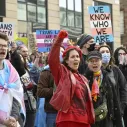A Look at Singapore: The Green-Branded City-State
archive
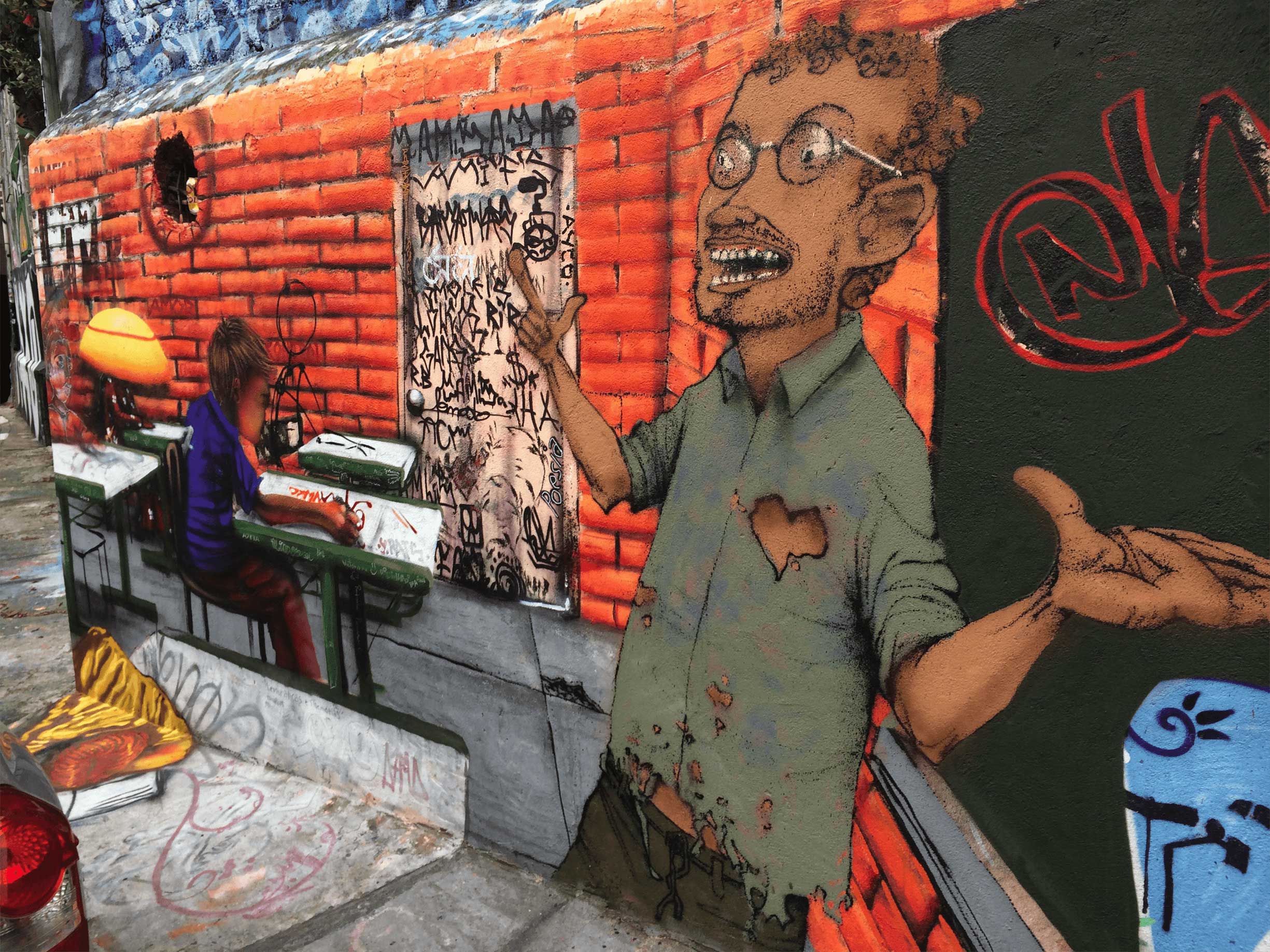
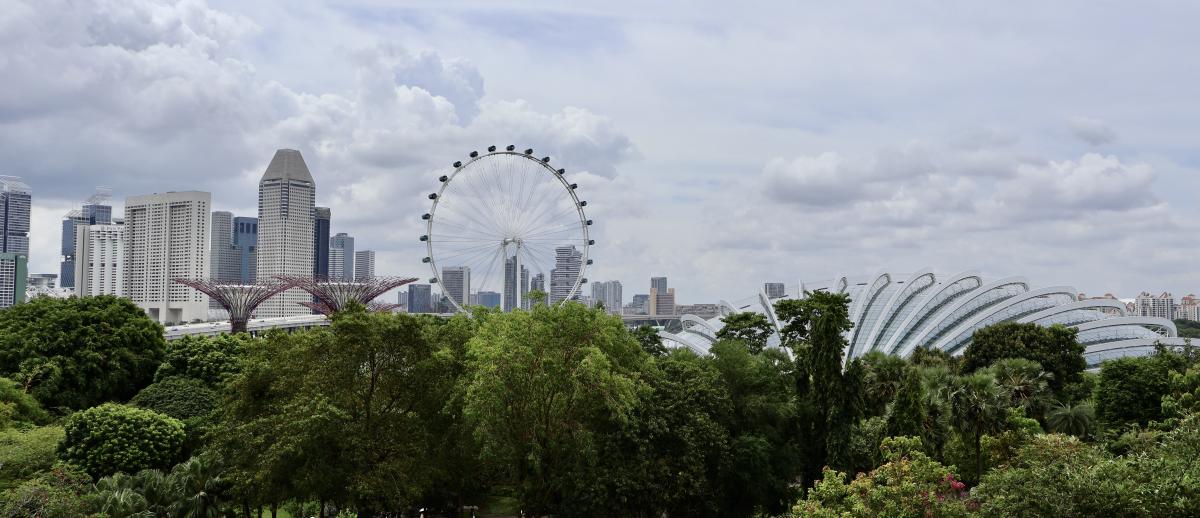
Green megastructures at Gardens by the Bay are the heart of ecotourism in Singapore - photo by author
A Look at Singapore: The Green-Branded City-State
The island country of Singapore is globally recognized as an environmental beacon: an eco-friendly model of the future. Its nature-mocking megastructures and sparkly clean streets—products of decades-long planning and securitized public order—have made the Southeast Asian city-state a pioneer in the era of urban greening (Han, 2018). As a geographically vulnerable and low-lying island, Singapore boasts a breadth of policies that fend off rising sea levels, harness solar energy and rainwater, and help fund installation costs for rooftop and vertical greenery projects (Lee; Xu; Kua, 2023). Now, green space occupies nearly 50% of the island: an impressive figure backed by masterful city design and decades of development—and redevelopment—to maximize its limited 710 square kilometers of space for nearly 6 million people. A meritocratic society, Singapore has branded itself a nature-immersive city, propagating an image—both across the nation and the world—of the young country as an idealistic, even futuristic, green haven.
During several months of ethnographic fieldwork, I explored Singapore’s green spaces to learn how residents interact with the self-proclaimed “City in Nature.” I moved beyond iconic spectacles like the steel Supertrees and Changi Airport’s waterfall to visit everyday green spaces actually frequented and used by locals. Through observations, interviews, and on-the-ground engagement, I searched for the lived realities of the city’s residents, examining both how the city-state embodies an urban ecosystem driven by inclusion and environmental justice, but also how it falls short: prioritizing economic and industrial gains, perpetuating social inequities, and potentially pushing forward a greenwashing enterprise.
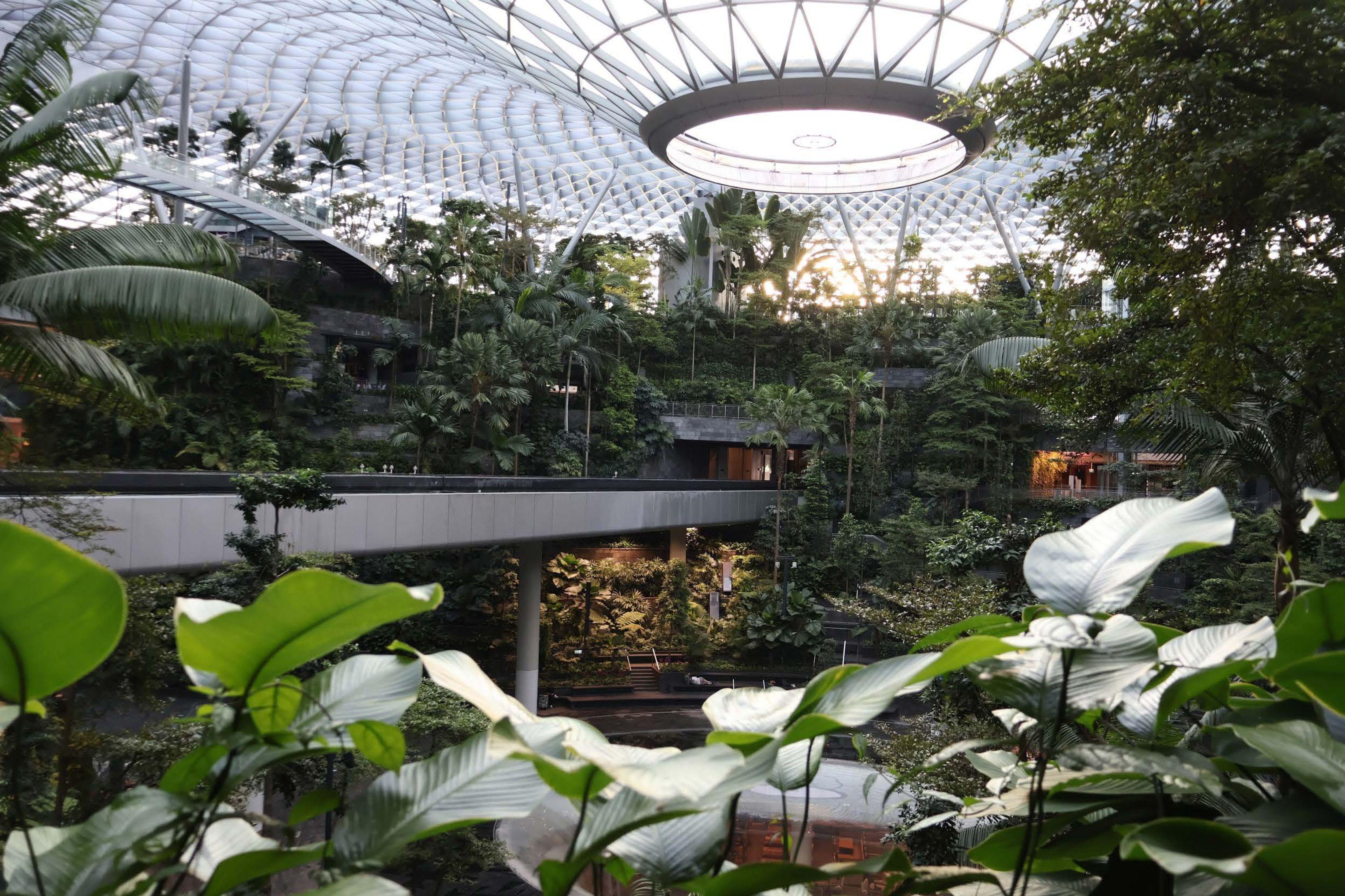
At Singapore’s Changi Airport Terminal 1, “Jewel” holds a gargantuan indoor waterfall enclosed in a tropical forest-style setting - photo by author
A Brief Background
Since its formal statehood began in 1965, Singapore’s policies—spearheaded by its first, decades-long prime minister Lee Kuan Yew (LKY)—have concentrated on becoming green and clean. After the nation’s departure from Malaysia, Lee created and promoted policies that encouraged citywide cleanups and future-focused urban planning alongside burgeoning economic development, international trade, and foreign investments. Control and cleanliness began to shape the ex-British colonial landscape: Singapore’s food street vendors were shepherded into organized hawker center food courts, residents were filed into towers of subsidized housing flats, and systems for waste control and sewage were solidified to clear polluted waters and skyrocket public hygiene (Chia Yeong; Joshua; Lim, 2012). Also on the agenda was improving the local environment to have greater greenery and shade for the livelihood of Singaporeans—a priority that has now become a pillar of national pride. Prime Minister Lee coined Singapore the “Garden City” in 1967, and was famously captured planting an African Mahogany tree to launch his island-wide tree-planting initiative—a campaign that has lasted over 60 years. The initial Garden City state motto was in the 1990s recoined as “City in a Garden,” and with the launch of a new green plan in 2021, Singapore began its official pursuit of a liveable “City in Nature."
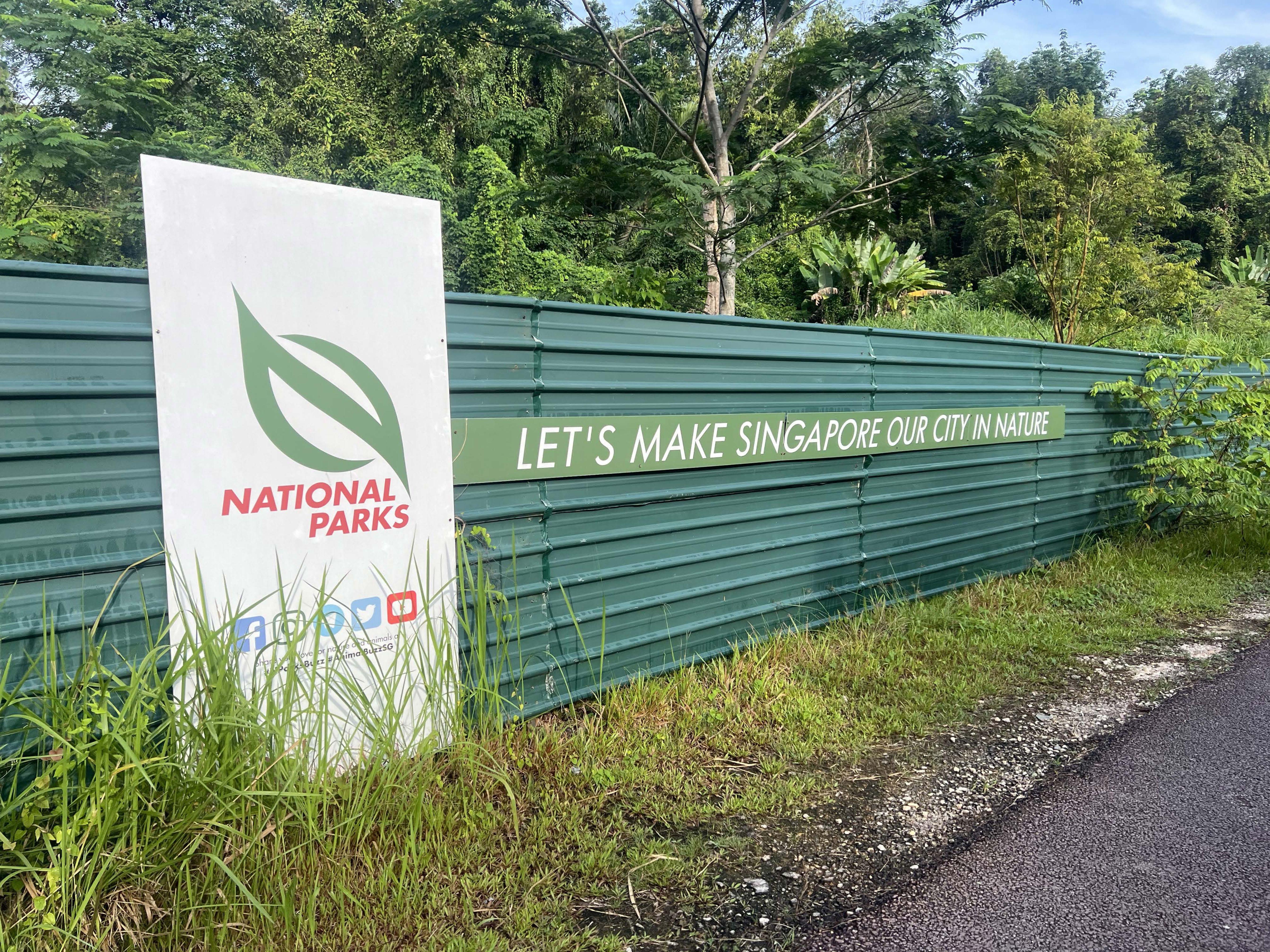
Singapore’s National Parks Board promotes its City in Nature motto along the busy Rail Corridor, a former British railway transformed into walkable green space. - photo by author
Parks for the People
Singapore maintains nearly half of its island as green space—an astounding statistic made possible by strategic city planning. Some of this greenery is vertical: high-rise balconies, roofs, facades, terraces lined with trees and plants are designed to capture heat and carbon emissions while reincorporating nature in a densely populated city (Tng, 2025). While these green infrastructures capture the attention of many outsiders, I sought more usable nature-immersive spaces in a green-branded Singapore. The answer was parks: the spaces that are public, free, and bring an element of nature into the entirely urbanized island. Singapore’s are managed by the National Parks Board (NParks), a statutory board founded in the 1990s to implement goals for a biophilic, or nature-loving, Singapore. NParks plans, develops, and oversees green spaces and policies across the nation, and in recent years, the agency has upped programs for conserving resources, fostering biodiversity of indigenous species, and management of urban ecosystems to relay goals congruent with a City in Nature.
Over several months, I traversed dozens of Singapore’s 400 nature parks, often interviewing locals about why they came to a given park. I also became a visitor myself: capturing photos of tropical flora and fauna and strolling through parks to see what each had to offer. Some neighborhood parks were suited for biking and running, with long, narrow stretches and leaf-lined paths, while others were equipped with benches and stationary workout equipment. Many even share a network of park connectors, or green corridors, that allow residents—both human and nonhuman—to move between different nature areas and parks.
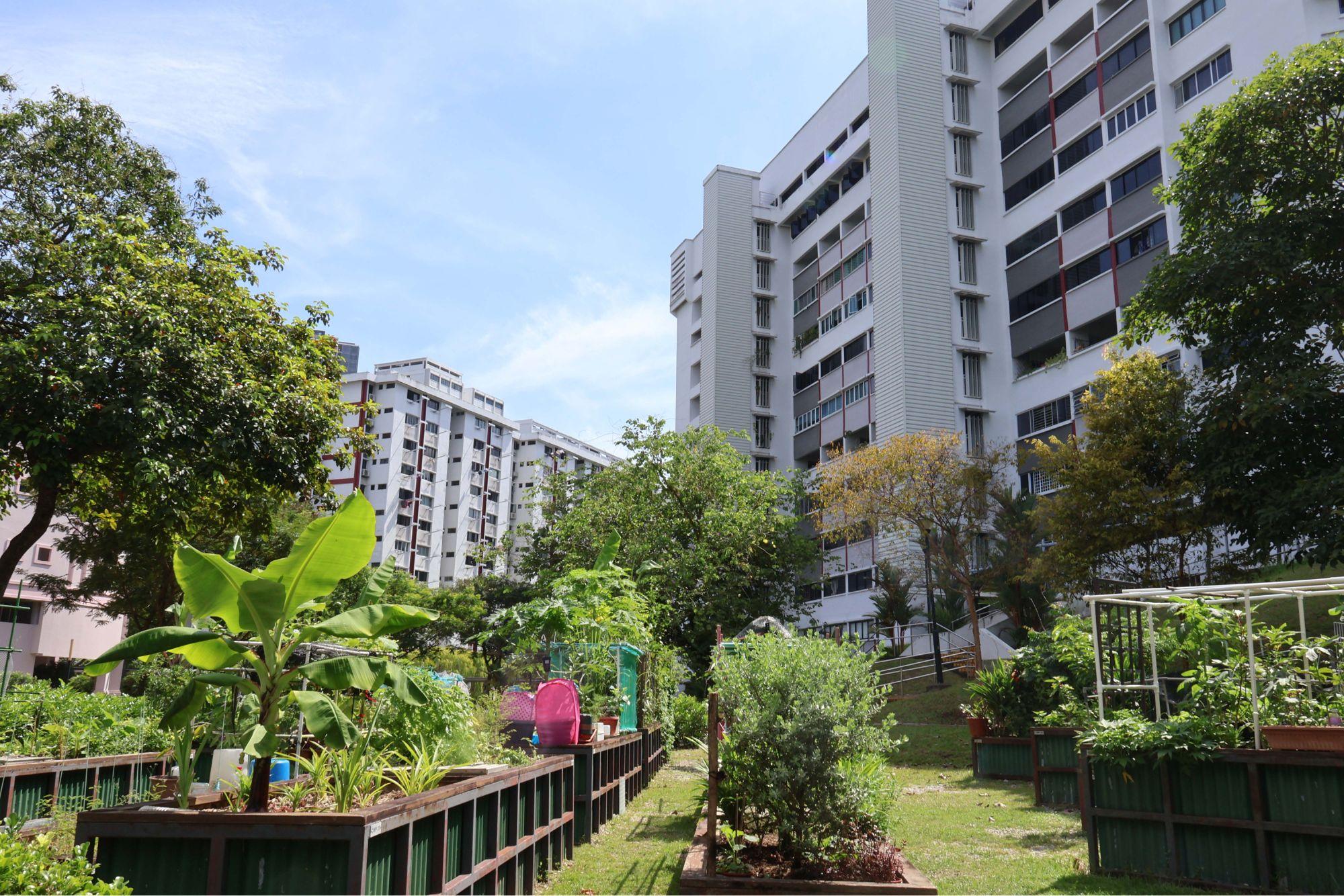
Allotment garden beds plotted beside an HDB public housing block allow residents to harvest produce in personal gardens, picked on a lottery system - photo by author
Yet in my hunt to see what made a green space usable and frequented, I was faced with the underwhelmingly obvious: locals often picked a park based on its convenience and location. A regular reality of not having an automobile, for which just an ownership certificate is over $100,000 USD, makes the most walkable and close-to-home park the best, even if it isn’t the glitziest (Kok, 2023). For over 80% of the population living in Singapore’s government subsidized Housing and Development Board (widely known as HDB) flats, having localized, easy access to green space is valued and utilized. This plain truth was made evident by many of my observations and interviews. One afternoon at West Coast Park—a lengthy strip of green space sandwiched between a highway and coast-side construction site—I chatted with an elderly man, who told me he comes every day to stroll for an hour. When I asked him, “Why this park?” he shrugged and said, “I live nearby.” I soon realized that for him, and other parkgoers, it is as simple as that.
Singapore’s aging population exacerbates this effect, as the elderly often have less mobility or motivation for exploring a new park outside of their neighborhood, especially in the tropical humidity and heat. Choosing a green space, then, may just come down to its proximity from home. And I found myself in awe of how NParks has prioritized convenient—walkable or public transit-adjacent—green spaces for Singaporeans, with a current target for every household to be within a 10-minute walk from a park by 2030. In this vein, I see Singapore’s park system and widespread accessibility for citizens as a win for environmental justice and the lived experience of a so-called City in Nature.
Nature in the “City in Nature”
But one cannot ignore an irony that persists in Singapore’s claims of plentiful green space when most pre-existing wilderness has been destroyed in the creation of today’s manufactured ‘nature.’ Over 95% of the island’s native forest was cleared back in the 19th century, eradicating over a third of its species and making most of what lives today planted or artificial (Castelletta; Thiollay; Sodhi, 2004). Nonetheless, Singapore has taken great efforts to support conservation and rekindle biodiversity in an urban environment overrun by people—even though this usually manifests as constant rewiring and redevelopment. I wanted to learn just how prioritized the pillar of conservation was in Singaporean parks because, naturally, the City in Nature must have nature. And as opposed to the make-up of a garden that is often hedge-shaped and homogeneous, I recognize that the transition to the term “nature” in Singapore’s identity should embody some identifiable shift in its species composition and arrangement of greenery.
Retired NParks board member Lena Chan took me for a car ride on Upper Thomson Road, near Singapore’s MacRitchie Reservoir. Chan specializes in biodiversity, and spearheaded many of the team’s efforts to diversify Singapore’s plant and animal species. From the driver’s seat, she pointed to the center divider of the road, where planted flora intentionally mimics the layers of a forest. From shrubbery at the lowest level to hanging vines weaving through middle layers to tropical trees reaching over on each side to connect above the road, it was more calculated than any street side I had witnessed back home. Chan explained how a push for biodiverse nature—and not just uniform greenery—has resulted in multi-layered planting, which provides more green surface area and habitat niches for a greater range of species. Simultaneously, she said, the motto for a City in Nature means more sporadic planting and less precise planning with hopes of emulating the phantom tropical rainforest. Chan also outlined the ways that Singapore has strove forward as a biophilic city under the branding of “nature” as opposed to “garden,” highlighting a generational progression from the native species ousted during a past cluttered kampong life, to a reintroduction of their ecosystems and habitats, and subsequently, a healed relationship between Singaporeans and their environment.
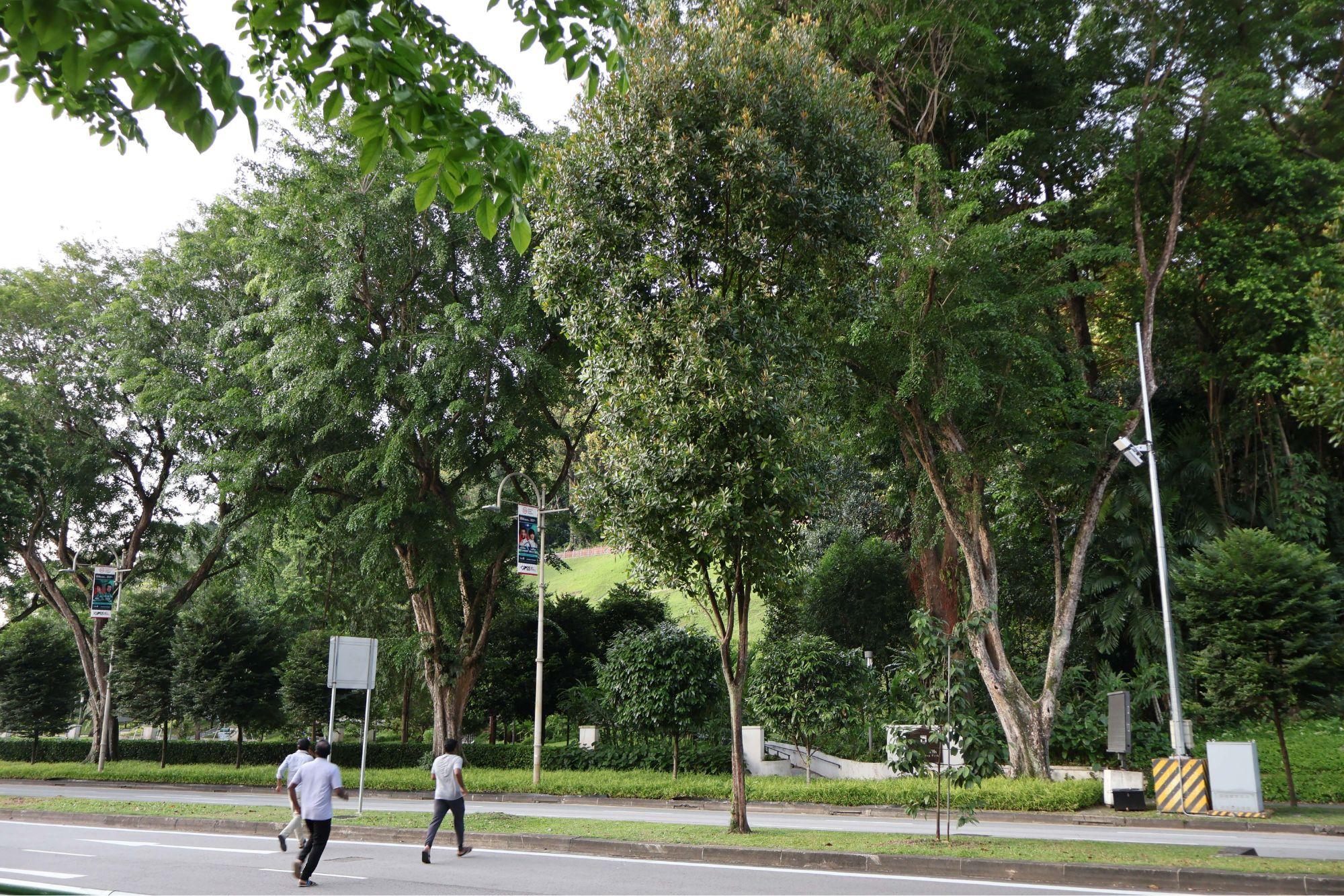
Multi-layered greenery shapes the streetsides of Singapore, mimicking the growth of an indigenous tropical forest - photo by author
While my research initially emphasized equal accessibility for Singapore’s human residents in green spaces, it was instructive to learn that Singapore has extended inclusion and access to nonhuman actors, placing the reintroduction of native species and the conservation of ecosystems at the top of its agenda. From the reintroduction and resurgence of freshwater crabs to native orchids, Singapore has made effective and evident strides forward in rewilding the city (Begum, 2024). NParks most recent target—alongside habitat restoration prorams—is to recover 100 plant and 60 animal species by 2030. This objective also produces a more biodiverse, less garden-like environment for Singaporean people to enjoy their nature-immersive city.
Built on the Backs of Migrants
But a City in Nature does not happen overnight. It’s a massive effort, and who is responsible? The manpower required for building and maintaining Singapore’s hyper-manicured cityscape does not fall on local populations, as is true with most developed nations. The weight rests on the shoulders of over 300,000 migrant workers, who occupy almost 40% of Singapore’s labor force (Lok, 2025). Male construction workers are contracted over in two-year periods from their home countries—most often Bangladesh, India, Myanmar, and China—for low-wage manual labor (Wee; Lam; Yeoh, 2022). These diasporas are housed in dormitories on the north-facing side of the island, where they live together in tightly packed complexes that are largely unreachable by public transportation. Instead of taking public transit to their work sites, the men are transported to and from their dormitories by open-backed trucks, lacking seatbelts, called lorries.
My admiration of Singapore’s environmental and green building feats was stunted by a realization that those responsible for the City in Nature simultaneously do not share equal rights to the green city. “Race matters in Singapore,” said a representative I interviewed from Singapore’s HOME: Humanitarian Organisation for Migration Economics. “Migrant workers are encouraged to stay in those parts of the country.” And, according to Sharon Tan from Singapore-based nonprofit Transient Workers Count Too, even in green spaces that are technically public, workers are not formally welcome due to a root cause of racial discrimination. Tan said that most Singaporeans are actually unaware of foreign workers’ poor living conditions and turn a blind eye to the fact that the green city they enjoy is built by those same people who are rejected from it.
I met with Lee Kah-Wee, National University of Singapore professor in urban planning, who shared an anecdote from 2020, when COVID spread rapidly through Singapore’s overcrowded migrant dormitories and exposed their inhumane housing conditions (Koh, 2020). But the consequent isolation and confinement of the foreign laborers also revealed their role in the City in Nature. As the group responsible for upkeeping the city, their absence became glaringly apparent. Lee described Singapore at that time as a nearly unrecognizable jungle, with “flowers blooming that I had never seen before.” This untouched, unruly cityscape forced a recognition that migrant workers are virtually responsible for the creation and cosmetic maintenance of green spaces in Singapore. And, in some ways, the phenomenon Lee divulged demonstrates the hyper-maintenance that Singapore still sustains, even as it’s departed from the branding of a garden city.
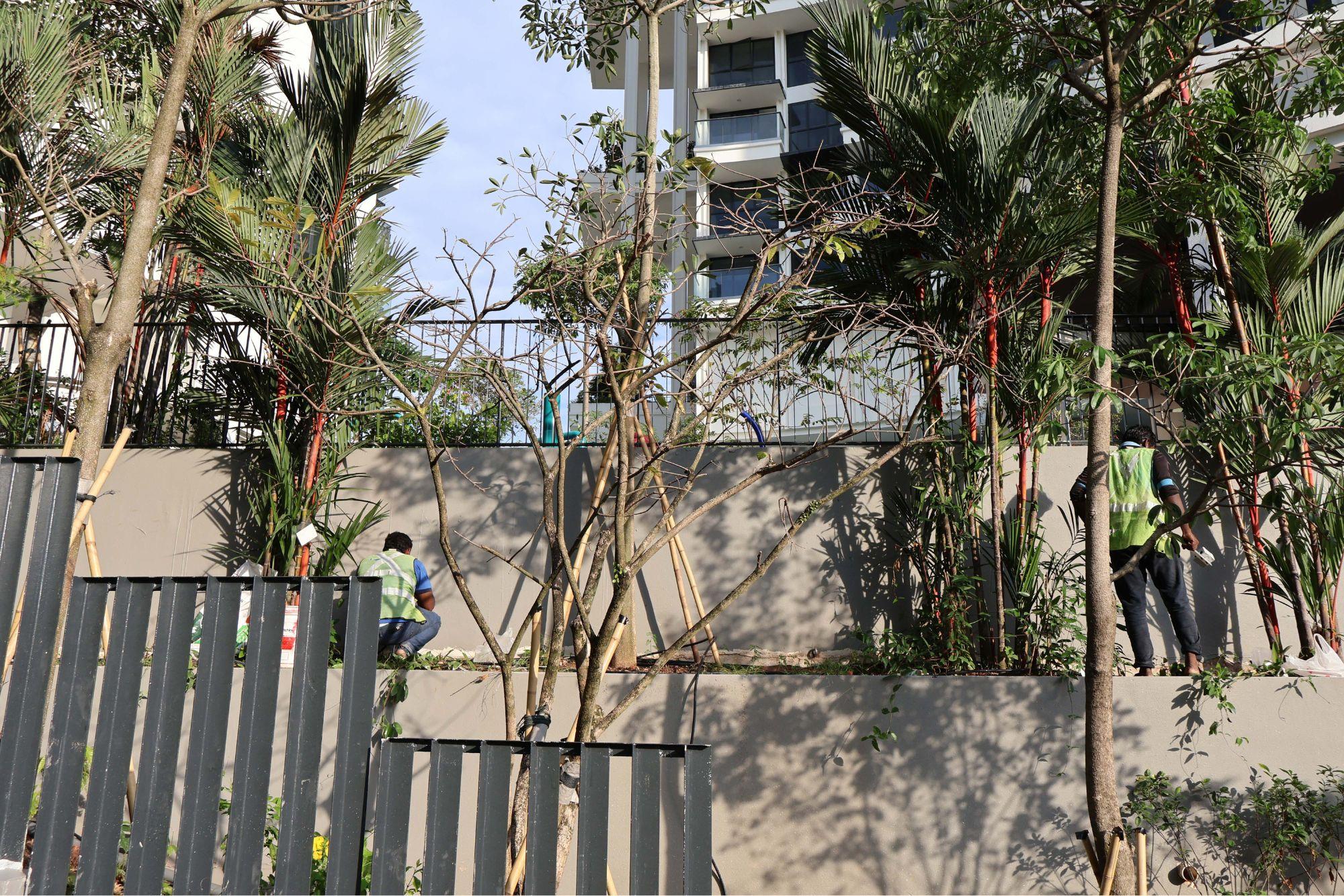
At Pearl’s Hill City Park, 22 acres in the center of Singapore, migrant workers stay until early evening to help plant the City in Nature - photo by author
I observed these workers everywhere I could, and found that almost every street, park, or outdoor space had some level of their gardening maintenance or construction projects in action. But this need for migrant workers is often unspoken in Singapore. Even if their presence and fruits of labor are highly visible, they are often overlooked, treated as invisible by the Singaporean state and citizens. While I had hoped to interview more migrant workers, I was limited in my access due to language barriers, restrictions from their dwellings, and hesitancy to disturb the foreign laborers in their working environment. I also realized—after speaking with NGO representatives—that their priorities were on food, housing, and income, not on whether they had fair access to green space. So I took to watching the foreign workers who were off the clock to see how they move throughout the City in Nature. During lunchtime breaks and while waiting for their ride home, I found these workers laying in fields on the streetside, crouching on electrical boxes, or just sitting on curbsides. The way they interacted with the city was entirely different from their Singaporean counterparts; the migrant workers did not appear to be integrated into green spaces, but temporarily occupying them.
I argue that the extent to which Singapore can be applauded for its greenness is limited by the experiences of these “others.” This phenomenon appears to breach environmental justice, defined by everyone having equal and fair access to environmental policies and their products. While technically, the migrant workers are not barred from visiting public parks and green spaces, compounding conditions of distance from home, extensive working hours, limited transportation, and other alienating forces have pushed them out of the City in Nature as members or guests, just servants. Though this is complicated by the migrant workers being short-term visitors—and many of them having arguably greater pay or more opportunities in Singapore than at home—the contradictions are apparent: they work for Singapore, the aspiring City in Nature, but it does not serve them.
Conclusion and Questions
In just 60 years, Singapore has made and enacted remarkable policies in its prioritization of extensive and accessible green spaces for its residents. The young nation has transformed parks into clean, public spaces that allow Singaporean residents—who rarely have private green space of their own—to engage with each other and nature. These good intentions, however, fall short in their perpetuation of inequities for marginalized groups like migrant workers, who do not have the same access to green spaces as their Singaporean counterparts. They are constantly shapeshifting the green cityscape, yet not welcomed to embrace it as locals.
The island country is designed to impress—and it does for good reason. But is the hallowed City in Nature a city for all residents? At what point is Singapore’s self-made label tainted by products of injustice within the clean and green machine?
Han, Heejin. 2018. “Governance for Green Urbanisation: Lessons from Singapore’s Green Building Certification Scheme.” Environment and Planning C: Politics and Space 37 (1): 137–156. https://doi.org/10.1177/2399654418778596.
Lee, Sheryl Tian Tong, Selina Xu, and Isabel Kua. 2023. “How Singapore Fights Rising Sea Levels.” Time, October 10.
time.com/6322111/singapore-fights-rising-sea-levels-climate-change/.
Chia Yeong Jia, Joshua, and Lim Tin Seng. 2012. “Keep Singapore Clean Campaign.” National Library Board.
www.nlb.gov.sg/main/article-detail?cmsuuid=b2c2c063-431a-4aa3-8c8d-02dc3b2a117d.
Tng, Serene. 2025. “Growing Plants in the Sky.” Urban Redevelopment Authority, July 14.
www.ura.gov.sg/Corporate/Resources/Ideas-and-Trends/Skyrise-Greenery.
Kok, Xinghui. 2023. “In Singapore, a Certificate to Own a Car Now Costs $106,000.” Reuters, October 4.
www.reuters.com/business/autos-transportation/singapore-certificate-own-car-now-costs-106000-2023-10-04/.
Castelletta, Marjorie, et al. 2004. “The Effects of Extreme Forest Fragmentation on the Bird Community of Singapore Island.” Biological Conservation 121 (2): 135–147. www.sciencedirect.com/science/article/abs/pii/S0006320704001740.
Begum, Shabana. 2024. “Knitting Nature into Singapore’s Urban Development.” The Straits Times, November 22.
www.straitstimes.com/singapore/knitting-nature-into-singapore-s-urban-development.
Lok, Cheryl. 2025. “Singapore’s ‘Invisible’ Population: The Perpetual ‘Homelessness’ of Migrant Workers.” Oxford Political Review, April 25. oxfordpoliticalreview.com/2025/04/25/singapores-invisible-population-the-perpetual-homelessness-of-migrant-workers/.
Wee, Kellynn, et al. 2022. “Migrant Construction Workers in Singapore: An Introduction.” In Migrant Workers in Singapore, xiii–xlix. https://doi.org/10.1142/9789811255038_0001.
Koh, David. 2020. “Migrant Workers and COVID-19.” Occupational and Environmental Medicine 77 (9): 634–636. https://doi.org/10.1136/oemed-2020-106626.


